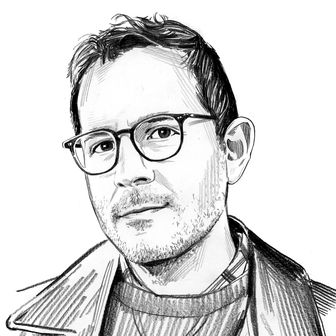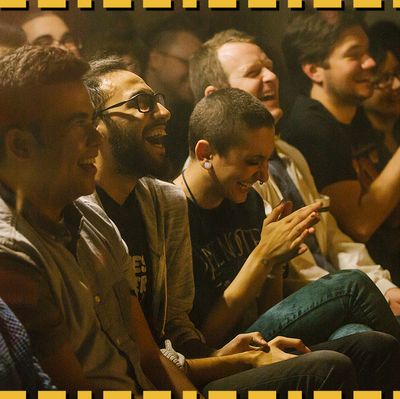
“What’s up, people of the sex shop?” asks Hannibal Buress into an overdriven microphone at 9:30 p.m. on a recent Tuesday in L.A. He’s standing in front of a wall of crotchless panties, and next to a black curtain that divides the part of the West Hollywood sex-toy shop where a customer is examining Fleshlights from the part where the bi-weekly comedy show Performance Anxiety is taking place. Buress is in town for the roast of Justin Bieber, and he’s at the Pleasure Chest to rehearse his set for a small but enthusiastic audience that’s doing its best to ignore the commercial for stainless-steel G-spotters playing on a TV to Buress’s right.
The sex-toy shop was the second place in two hours where I saw Buress, whose upcoming Comedy Central show had just been announced that morning. Earlier, he made a surprise appearance at Put Your Hands Together, a weekly stand-up show at the UCB Theatre on Franklin Avenue, to do the same roast jokes to a fully packed house. Of course he’s doing multiple sets: It’s Tuesday in Los Angeles, the best night for comedy in the country. I’d planned to see four shows, and I could’ve easily picked four different, equally great-sounding shows happening at the same time.
After both sets, Buress, as many comedians do at midnight on Tuesdays, came to the Belly Room at the Comedy Store to watch a show called Roast Battle. Roast Battle is a phenomenon in L.A. (and will be everywhere when a TV deal comes through, which it surely will) in which comedians, two at a time, face off against each other, trading insults. Looking around the room — to Buress’s left is Jeff Ross, the stand-up veteran who mentors this small show; behind Buress is Jerrod Carmichael, the young comedian with a Spike Lee–directed HBO special under his belt; to Buress’s right is Dave Chappelle, smoking cigarettes and laughing loudly at every joke; further back, the standing-room-only crowd is spilling into the hallway — one can’t help but feel that this is the epicenter of a boom.
It’s not just Los Angeles. There has never been a better time to be a comedian: The talent pool is broad, deep, and more diverse than ever before; a new generation of passionate fans is supporting experimental work; and there are countless ways (online, onscreen, in your earbuds, at live shows) for new voices to be heard and — not always a given when it comes to the internet — make a living. It’s a peak that hasn’t been seen since the first comedy boom, which lasted from 1979 to about 1995, and was defined by two stages: First, in the wake of the phenomenon that was Saturday Night Live, the popularity of George Carlin, Richard Pryor, and Steve Martin, and the debut of TV shows like An Evening at the Improv, hundreds of comedy clubs opened up overnight, resulting in a wave of frequently terrible observational comedians getting paid a lot of money to fill the bounty of open stages. Then, after the huge success of Seinfeld, Home Improvement, and Roseanne, many of those same comedians were all given sitcoms, most of which failed.
With clubs closing and TV deals drying up, alternative comedy began to rise from the ashes around 1995, with confessional comedians like Janeane Garofalo and Marc Maron pushing comedy shows into nontraditional spaces. That lit a long fuse that finally boomed in a big way in 2009: the year Marc Maron started “WTF”; the year Broad City launched as a web series; the year Aziz Ansari taped his first stand-up special; the year Rob Delaney joined Twitter; the year Parks and Recreation, Community, and The League premiered, and Ellie Kemper joined The Office; when it seemed like UCB was the unofficial farm team for Saturday Night Live and every sitcom on TV.
Prior to 2009, only three comedians had ever sold out Madison Square Garden (not the theater, the actual arena); three comedians have done it in the last three years, each multiple times. According to UCB, over 10,000 people will take improv classes in the U.S. this year. More people watched SNL 40 than the Golden Globes. Comedy Central’s original programming has nearly doubled in the last three years, in competition with other networks that have beefed up their own comedy offerings. The hiring of a new Daily Show host — congratulations, Trevor Noah — was treated with as much anticipation and passionate critique as when LeBron James decided to go play for the Miami Heat. About as many people follow Sarah Silverman on Twitter than follow Hillary and Bill Clinton combined. Critics revere Louis C.K. and Amy Schumer as geniuses. Practically every comedian has a podcast or web series, or both. Right now, comedy is bigger than it’s ever been. There are more people doing it, and more people enjoying it. Thanks to the internet, comedians now have infinite means by which to reach their fans; and those fans are more fanatical than ever. Welcome to the Second Comedy Boom.
“Amazon has shows, Netflix, YouTube, Hulu — there are a lot of different ways to get yourself out there as a comedian,” Buress told Vulture before the taping of the Bieber roast. “You can build yourself through the internet. People have been getting TV shows from having successful podcasts.” And even those who aren’t on TV are finding enthusiastic audiences, and ways to sustain a living in comedy on their own terms.
Thirty years ago, comedians had to fight for a few large slices of a small pie. In the ’90s, a few performers made millions as stars of network sitcoms, but most were left in the cold when comedy clubs started shutting down. Now the pie is bigger and slices more plentiful, which benefits everyone from Buress (who now draws paychecks as a star on three cable shows) down to the armies of unknown UCB performers getting paid to make videos for Funny or Die and College Humor.
Podcasting is just one of the many ways by which comedians can develop a fan base, but over the last couple years, it’s also become one of the most lucrative. According to Adam Sachs, the CEO of Midroll — the company sells ads for popular podcasts such as “WTF With Marc Maron,” Scott Aukerman’s “Comedy Bang! Bang!,” Pete Holmes’s “You Made It Weird,” and Paul Scheer’s “How Did This Get Made” — “many comedians could survive today with the revenue from their podcasts alone.” Sachs says a podcast with 40,000 downloads per episode can gross well over $75,000 a year, and shows in the 100,000-download range can gross somewhere between $250,000 and $400,000. He estimates that three or four Midroll podcasts will make over $1 million this year. This has been a boon to comedians like Maron, Aukerman, Chris Hardwick, and Bill Burr, comedy veterans who had to wait for the boom to truly break through — all of whom have recently parlayed successful podcasts into cable-TV shows and larger fees for stand-up appearances.
“Pretty much all of my friends that came up with me in comedy are working,” says Kristen Schaal. “Television is in a golden age, and now there’s like 2,000 channels for comedians to play around on.” Instead of broad network sitcoms, more comedians are getting small, idiosyncratic shows on cable or streaming sites. In the last five years, Comedy Central has seen increased competition from IFC, FX, FXX, Fusion, TBS, Netflix, Amazon, Hulu, Yahoo, and TruTV.
Broadcast networks have also been getting smaller and stranger lately, as with Fox’s brilliantly weird (and well-rated) The Last Man on Earth. Vulture’s Josef Adalian explains that “with most new network comedies in recent years getting ratings not much higher than cable,” networks are realizing they might as well aim for “cable quality.” The ultimate goal for a comedian in 2015 isn’t starring on his or her own Home Improvement, a mainstream sitcom that waters down their stand-up material — it’s having their own Louie, a show on which the creator retains full auteurist control over every weird aspect: Kroll Show, Broad City, Comedy Bang! Bang!, The Last Man on Earth, The Eric Andre Show, NTSF:SD:SUV, Inside Amy Schumer, Nathan for You, Lucas Bros. Moving Co., Mulaney (yes, Mulaney might’ve seemed like a traditional broad sitcom, but the point is that was exactly what John Mulaney wanted), and others were all created, written, and headlined by their comedian stars. None of these performers are rich for life thanks to their shows, but they’re all earning a living doing artistically fulfilling work.
Compare this to the grind of the original comedy boom, during which, to eke out a decent income, a comedian had to tour the country doing the same 45-minute set. As Marc Maron explained to me over the phone, comedy clubs of the time were a “bar business, [they had] never been a show business. You were there to sell drinks.” Discos were dying, and comedy was the word. Richard Zoglin, explaining the original Comedy Boom in his 2008 book Comedy at the Edge, wrote: “An evening at the comedy club was perfect entertainment for a baby-boom generation that was just hitting its peak dating years. You could take a date to the movies, but the conversation had to wait until afterward. The discos were too noisy. At a comedy club you could talk during the show, gauge each other’s reactions, see what your date laughed at — or was grossed out by.”
To today’s fans, comedy is more than just background noise: “Millennials have a deeper connection to comedy than previous generations,” says Chanon Cook, Comedy Central’s head of research. According to Cook, it was television that made the difference. The explosion of comedy on TV helped kill comedy clubs and bring the original boom to an end — but the biggest stars of that boom wound up on Saturday Night Live or on their own sitcoms, many of which were essential viewing for millennials, planting the seeds of the second boom. Endless reruns of Seinfeld and stand-up specials on Comedy Central gave this generation an inbuilt awareness of comedy’s conventions: The comedy nerd was born.
As Comedy Central claimed in an (admittedly self-serving) 2012 survey, millennials are the first generation that views humor as the most valuable part of their self-definition. “Comedy is to this generation what music was to previous generations,” Cook says. “They use it to define themselves. They use it to connect with people.” Maron described comedy nerds to me as “people who are into different facets of the history of comedy, the different types of comedy.” Says Pete Holmes: “The comedy audience of 2015 is like the guitar to the musician. They’re not just sitting there to get fucked up and smoke a cigarette inside, which is what it was in the ’80s; they’re there to actually participate in something.”
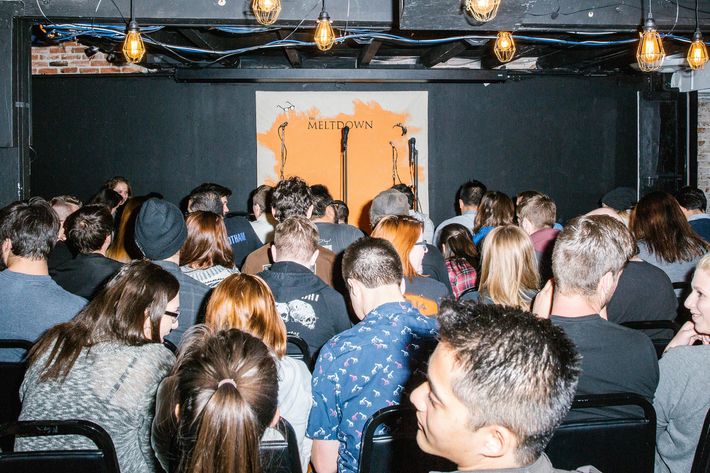
On Wednesday in L.A., I saw this type of fan in action at The Meltdown, the best comedy show in the city. Situated at NerdMelt, the West Hollywood comedy theater in the back of a comic-book store, produced by Emily Gordon, and hosted by comedians Jonah Ray and Kumail Nanjiani (who is Gordon’s husband and a star of HBO’s Silicon Valley), The Meltdown has run for five years and last year became a show on Comedy Central. With 200 people crammed into a 150-person space, the room was hot — figuratively hot and, thanks to L.A.’s late-winter heat wave, literally hot. The stage is less a stage and more a place where the chairs stop and the lights shine. The audience …Well, the audience is something. I’ll let Ray describe it:
They are some of the most dedicated, sweetest weirdos around. When we started, there were these different people that we would recognize, and they slowly started sitting closer to the stage, and they all started to become friends and know each other. Now, every week, the first three or four rows are the diehard regulars. They’re creatives and artists and comics themselves, and them knowing each other, and us knowing them, has created an amazing dynamic for Kumail and I to play with.
Gordon would tell me later that the week I was there, one of these fans got a tattoo of the hand stamp given to The Meltdown attendees.
Diehard fans, like those of The Meltdown, are now the norm at comedy shows around the country. Because of them, comedy has fundamentally changed in the following ways:
1. Comedy is more meta.
Modern fans’ familiarity with the way comedy works means that the content of the comedy is often based in the process by which it’s created. “There’s a sophistication [in the audience] that wasn’t there back in the Evening at the Improv days,” Holmes tells me, referring to the 1980s stand-up TV show. “They know what a bit is.” Holmes, like most comedians in 2015, addresses the fact that he’s doing stand-up while he’s performing. Early in my week in L.A., at UCB’s monolithic Thai Town theater, Holmes closed the weeklyshow stand-up show Church, following Melissa Villaseñor, who destroyed the audience with a series of impressions ranging from Pikachu to Wanda Sykes. Taking the stage, Holmes sighed: “Well, she killed. Great.” He began his set: “My dog got sprayed by a skunk today — another comedian would then do 20 minutes of perfect material about that,” he said, mocking comedians who say things happened to them recently when, in fact, the things happened ages ago, whenever the performer started working on that joke. (Nowadays you’ll often hear jokes that start like, “A week ago — or a week ago from whenever I wrote this bit.”) His set’s biggest laugh probably came during a bit about having a dog despite having grown up with cats, riffing, “Ooh, a comedian talking about the difference between cats and dogs.” Comedy nerds are as interested in the source code as they are the jokes themselves. In 2015, the source code is the jokes.
2. The line between fan and performer is blurred.
The UCB Theatre has done plenty to help foster the second comedy boom — popularizing improv, launching countless star performers, serving as the comedic hub for both New York and L.A., providing budding comedians with free stage time — but its most important contribution is the way it changed the relationship between audience and performer. According to Kevin Hines, from the UCB Theatre’s training center in New York, 11,918 students took classes at UCB NY or LA last year. 11,918! (About 6,400 of those took Improv 101, the theater’s entry-level class, which is twice as many that took the same class five years ago). At UCB, everyone performs, and everyone watches everyone else. It’s a scene, not just a bunch of shows. Pete Holmes, who took classes at UCB while pursuing stand-up, explains: “I like doing stand-up like improv, by looking at the audience as your scene partner.” At a comedy show in 2015, everybody works together to create the best show possible. Everyone’s a comedian.
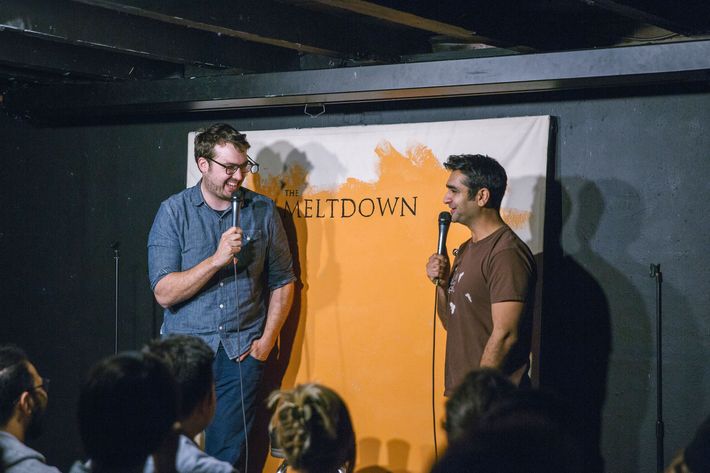
3. Comedy is more conversational and less punch-line-driven.
Today, audiences expect comedians to talk to them like peers — they don’t like being performed down to. “[Comedy’s] changed and become more conversational,” Nanjiani says. “People are okay listening to a podcast that’s an hour and a half, and it’s not funny, funny, funny, funny.” Nanjiani says those fans “take that expectation to a comedy show as well,” and as a result, he’s learned to “hide his punch lines” so as not to seem detached. Now Nanjiani and Ray often go into The Meltdown shows without any particular plan, and essentially just hang out for a few minutes. “Comics that don’t make an effort to exist in that moment with everybody else in the room tend to get a colder reaction,” says Ray.
This was on my mind as I watched comedian Mark Normand take the stage at The Meltdown. Two days earlier, at Hot Tub, Kristen Schaal and Kurt Braunohler’s weekly show, he had a rough go of it, telling well-crafted jokes (i.e., “I look at racism the same way I look at Nickelback: It’s fun to joke about, but ugh, you never want to see it live”) that would get short pulses of laughter instead of the bigger, rolling laugh of a fully engaged audience. The distance increased as Normand blamed the crowd for being too sensitive. He was trying to deliver his best material to an audience that didn’t want “material” at all — they just wanted to just get to know him. He connected better at the Meltdown. Setting up a set of jokes about homophobia, he asked if there were any gay guys in the audience. When no one responded, he joked, “Well, that is statistically impossible, [especially here,] in the back of a nerd museum.”
4. Experimentation is expected.
Kristen Schaal, however, killed at both Hot Tub and The Meltdown with one of the funniest things I’ve seen in years: a one-woman show about Emily Dickinson (titled Emily Dick-unsung). Schaal’s version of Dickinson is a spinster with messy hair who hides poems around the stage and asks audience members to read them. One poem was just a grocery list, but Schaal acted as though it contained her innermost secrets: “This poem is not ready for the world!” Another poem was actually just an olive in a folded piece of paper; she made an audience member “read” it by eating the olive. The bit doesn’t make much sense (especially when one attempts to describe it after the fact), but it destroyed both of the audiences I saw it with. I learned later that these were only the second and third times she’d ever performed it.
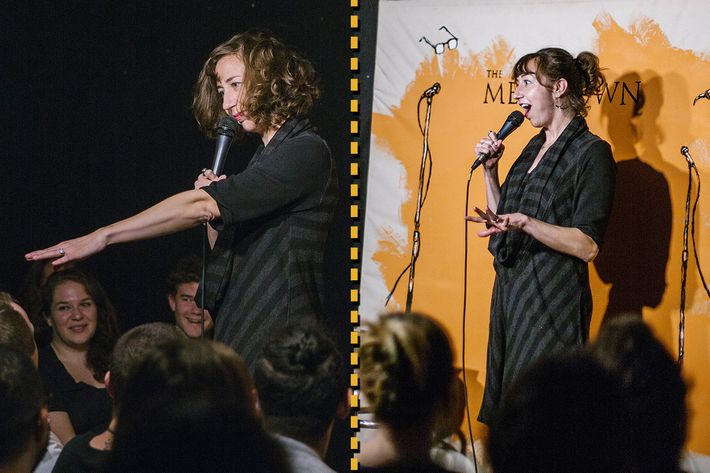
In 2015, audiences are happily willing to follow comedians down any rabbit hole, no matter how unlikely the payoff. Sure, experimental comedians have existed since the ’70s – Steve Martin, Andy Kaufman, Emo Philips, etc. — but no longer are they the exception, as comedy-nerd audiences expect and are ready for comedians to have fun with the form (especially, for the first time, not just white males). Watch Rory Scovel’s brilliant set from The Meltdown TV show, for example. Scovel takes the stage and, responding to the audience’s enthusiastic welcome, ditches his planned material, and tells the crowd to keep clapping for the entirety of his ten-minute set. It’s an odd bit, especially considering that it’s being taped for television. He doesn’t tell jokes. He just offers a running commentary on what’s happening and eggs his audience on. He wonders what it would be like to be a TV viewer tuning in halfway through the bit. Eventually, he becomes mock-angry at his at-home audience: “Stay the fuck out of here!” he shouts at the camera. “This is our time down here!” At the end, the claps become a standing ovation, and Scovel seems actually touched that everyone went along with this very silly idea. Even in the two minutes and 41 seconds that aired on Comedy Central, you can see exactly what comedy looks like right now.
So, where to from here? Actually, comedy’s next generation is already beginning to emerge. Back in New York, I go to the Holy Fuck Comedy Hour, a madcap weekly sketch show at the new Williamsburg location of the Annoyance Theatre. Started in Chicago in the late ’80s, the Annoyance has been a launchpad for many comedy careers — including those of Stephen Colbert, Jane Lynch, Jeff Garlin, Vanessa Bayer, Jason Sudeikis, and others — though Second City, where those Chicagoans would also perform, usually hogs credit for them. The Annoyance’s month-old New York location, below the Williamsburg Bridge and underneath a jazz club, seems to be their attempt to assert themselves as the alternative to the former alternative, UCB.
“Loud-lings” is how I like to describe the Holy Fuck Comedy Hour, which mixes Chicago-style brashness with the character focus of L.A.’s Groundlings. Perhaps to drown out the jazz coming from upstairs, everything is turned up to 11: Each sketch ends with someone onstage giving the cue to hit the “lights”; New York’s most inventive stand-up, Jo Firestone, asks the audience to shout out “sunshine, lollipops, or rainbows” whenever they want to interrupt her deadly serious (and hilarious) one-woman show about moving to New York; for a sketch in which gay parents bring their straight son to a doctor to turn him gay, a projector screen plays gay porn (with the actor who’s playing the son’s face Photoshopped onto every porn star’s) on a loop.
The sketch of the night is slightly more subdued, but just as absurd. A woman comes onstage wearing a Saturday Night Live T-shirt, thumbing through her copy of the definitive SNL oral history Live From New York, geeking out just at the names of the people who agreed to be interviewed — “Bill Murray, hehe, awesome!” Then a boy comes onstage and asks what she’s reading. They flirt by repeating iconic SNL catchphrases (“Choppin’ broccoli!?”). The audience, packed densely enough to worry any good fire marshal, laughs knowingly. The woman is Claire Mulaney (John’s younger sister), a writer for Saturday Night Live, who is there performing the sketch on her week off. This is more than meta comedy for an accepting audience; it’s damn near postmodern. The sketch ends with Mulaney and her new beau screaming, “Live from New York, it’s Saturday Night!!!!!” Mulaney laughs. We all do. “Lights!”
Additional reporting by Rich Kane.


